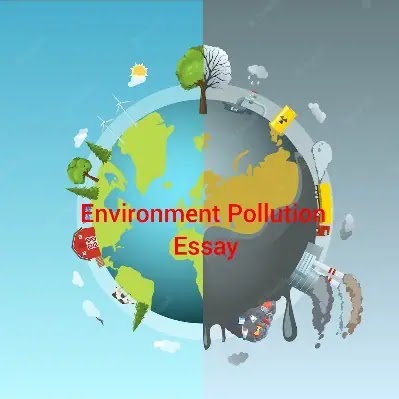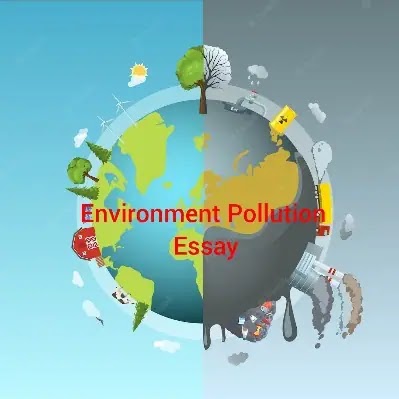Environment Pollution Essay: Types Causes Effects Solutions

Environment Pollution Essay in English
Introduction: What is Pollution
Pollution is an undesirable change in the physical, chemical or biological characteristics of air, water and soil that may harmfully affect the life of any living organism. In other words, pollution is the effect of undesirable changes in our surroundings that have harmful effects on plants, animals and human beings. Pollution is caused by the presence of pollutants in the air, water and soil. The pollutants include solid, liquid or gases present in greater than natural abundance and have a detrimental effect on our environment.
Types of Pollutants:
From ecological perspective, pollutants can be classified as follows:
(a) Degradable or non-persistent pollutants:
These can be rapidly broken down by natural process e.g. domestic waste, discarded vegetables and sewage.
(b) Slowly degradable pollutants:
They can not be degraded by natural process e.g elements like lead, mercury, nuclear wastes and glass. The pollutants can also be categorized as follows:-
I. Primary Pollutants: The pollutants that persist in the form in which they are released in the environment e.g. DDT, CO, Plastic and glass.
II. Secondary Pollutants: The pollutants which are formed from other pollutants due to change or reaction e.g ozone, peroxyacyl nitrate.
III. Qualitative Pollutants: The pollutants is not a natural component of environment. It is a harmful substance added by human beings e.g insecticides, herbicides.
IV. Qualitative Pollutants: These are normal components of nature that become pollutant when their concentration becomes higher than the normal e.g Carbon monoxide and nitrogen oxides.
◇ Types of Environment Pollution:
Pollution is of different types. It is of many types like air, water, soil, marine, noise, thermal and nuclear pollution. Air, water and noise pollution are very common and much studied types of pollution.
1. Air Pollution:
Air pollution is one of the most dangerous and common kind of environmental pollution. Air pollution is reported in most industrial town and metropolitans of India and abroad such as Delhi, Mumbai Calcutta, London, New York and Tokyo. Some famous air pollution incidents in modern times are as follows –
● Mcuse valley of Belgium in 1930.
● Killing smog in Donora, Pennsylvania in 1948.
● Smog in London in 1952 killing 4000 to 5000 people.
● Bhopal gas tragedy of Union Carbide in 1984.
◇ Effects of Air Pollution:
Air pollution is considered to be more serious than any other type of pollution. This is because, air is needed for breathing of man and other animals.
a. Changes of climate:
Air pollution is responsible for bringing changes in climate. This includes the Green House Effect. Green House effect is the increase in atmospheric temperature due to increase in concentration of Green House Gases, especially Carbon-di-oxide and methane.
b. Ozone Depletion:
Pollution due to increased levels of cholorofluorocarbons and nitrogen oxides cause depletion of ozone layer in the stratosphere. There is almost negligible Ozone layer over Antarctica, and it is called ozone hole depletion of ozone layer causes more ultra. Violet rays to reach the surface of earth. This causes reduction in photosynthesis, increased blindness in animals and skin cancers in people.
c. Acid rain:
Acid rain is the Indirect impact of air pollution. Acid rain is due to excessive amount of Sulphur-di-oxide and oxides of nitrogen in the air. The acids fall on earth with rain called Acid rain. Acid rain has destroyed more than 50% forests in Germany, Poland, Switzerland.
◇ How to Control of Air Pollution:
1. Tress and shrubs be planted in all the available spaces especially around the industrial areas. Tress remove dirt and harmful gases from the air.
2. Tall chimneys should be used to disperse smoke high in the air.
3. Non-leaded petrol should be used in vehicles.
4. Low-sulphur diesel should be used.
2. Water Pollution:
Water is an essential commodity that makes life possible on earth. Infact life originated in water. Water pollution occurs due to addition of three categories of pollutants i.e physical, chemical and biological. Water pollution can occur due to natural or man made sources.
◇ Sources of Water Pollution:
Water pollution is caused by human activities like industrial effluents, domestic sewage, detergents, pesticides, fertilizers and oil spills.
◇ Effects of Water Pollution:
Water pollution affects the health of all the organism that use it. Some of the effects of this evil have already been discussed. More effects of water pollution are given as under.
a. Chemical Pollutants:
The sources of mercury, cadmium, lead, sulphates, nitrates and persistant pesticides have bad effect on water and causes water pollution.
b. Colour and odour:
The water becomes coloured due to dyes, chemical compounds of iron and chromium. This water is rendered unit for drinking and industrial purposes.
c. Turbidity:
Turbidity is due to mud or suspension of dust, silt and related colloidal particles. It hinders light penetration to the deeper layers affecting photosynthesis. Turbidity also causes clogging of gills in fishes. This water is not suitable for drinking and industrial use.
d. Pathogenic diseases:
Water pollution is source of a number of waterborne diseases such as gastroenteritis, cholera, jaundice etc.
◇ How to Control of water pollution:
1. Adequate treatment of sewage and industrial effluents:
Raw sewage should not be dumped into rivers or oceans. Before discharging sewage and industrial effluents into water bodies, they should be properly treated. The sewage treatment is usually performed in the following three stages:
a. Primary treatment:
It removes large objects and suspended solids and converts them into sludge, a valuable fertilizer.
b. Secondary treatment:
During this stage, aeration is supplied and the bacterial action decomposes organic compounds into harmless substances such as Carbon-di-oxide, sulphates and water.
c.Tertiary treatment:
It removes phosphates, nitrates and release pure water. This stage is very costly and is used for recycling of water. It is rarely undertaken.
3. Soil Pollution:
Soil is a thin covering over the land consisting of a mixture of minerals, organic materials, air and water that together support the growth of plant life. Soil is a resource for which there is no substitute. Soil pollution can be defined as the unfavourable alteration of soil of tge addition or removal of minerals leading to reduced productivity. The substances that reduce the productivity of soil are called soil pollutants.
◇ Causes of Soil Pollution:
The soil pollution occurs due to following activities of process:
a. Erosion: Soil erosion is the movement or washing away of the surface. Apart from the natural causes of soil erosion, i. e water and wind, erosion is greatly accelerated due to human activities such as deforestation, burning of grass cover and farming.
b. Pesticides: Pesticides are the chemicals used for killing pathogens, pests and unwanted plants (weeds). There are different categories of pesticides used in farming that trigger the soil pollution.
◇ How to Control of soil pollution:
● Recycling of wastes.
● Effective forestation.
● Vontrolled grazing and soil binding gases.
● Cow ding, human excreta and garbage can be mixed and used for generation of biogas.
4. Noise Pollution:
Noise pollution is an undesirable and unwanted sound of any kind. On the other hand, music is a sound having pleasant effect on ears and mind. A given sound may appear music to one and noise to others.
◇ Sources of noise pollution:
The sources of noise pollution are both natural as well as man made. The natural sources include thunder of clouds. Most of the noise pollution is man made and includes the following sources:
● Industries
● Defense equipment
● Transport vehicles
● Domestic gadgets
● Personal entertainment
●Blasting, bulldozing, stone crushing and construction work
◇ Effects of noise pollution:
There are two main effects of noise pollution. First, problem in hearing ability and the other on general health of man.
a. Effects on hearing ability: Exposure to noise causes damage to membrane of the ear drun and people become deaf due to continuous noise pollution.
b. Effects on general health:
● Creation of stress and anxiety.
● Headache
● Dilation of pupil
● Emotional disturbance
● Weakening of heart
● Nervous breakdown
● Fluctuation of blood pressure
◇ How to Control of Noise Pollution:
There are three types of measures that can be adopted to control noise pollution:
a. Reduction of noise source
b. Machines should be lubricated
c. Setting industries away from human habitation
d. Use of ear muffs and cotton plugs in noisy area.
Conclusion:
Pollution is a man-made problem. Everyone of us is responsible for the degradation of our environment. The nature has its own mechanisms to reduce the levels of air, soil and water pollution provided the natural mechanisms are not overloaded beyond their capacity. The quick solution of all forms of pollution does not lie in technological development for the control of pollution. The only thing is that we need to make major changes in our life styles that would contribute to a cleaner environment.
You May Like To Read More:
